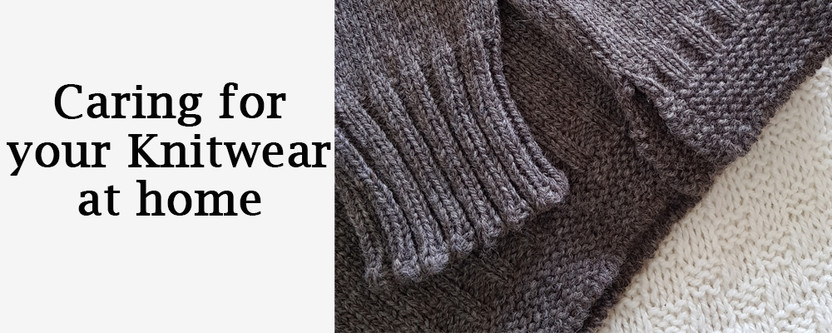Caring for your Knitwear at Home
Posted by NZNC Team on 20th May 2022
For all of the natural brilliance of materials like wool and silk, the one thing they are is vulnerable to is the household washing machine.
Although most care labels will say hand wash only, most modern machines will have a wool or delicate setting that is gentle enough to take care of those precious garments.
Putting your woollens in with a mixed load is like putting your fine china and crystalware in the dishwasher. It’ll be clean but there is a risk you’ll never use it again. So don’t do it.
The time you thought you were saving by avoiding a dedicated wash is nothing compared the cost of replacing the ruined garment. Especially if it was made from a premium fibre like Merino or Possum.
However, garment care for premium fabrics doesn’t start or end with knowing which cycle to use on your washing machine. Here are our top 3 tips for caring for Merino and Possum wool blends at home:
1. Laundering
It’s both surprising and a little depressing at how frequently people make assumptions that because modern machines are more sophisticated that somehow their luxury jersey will be magically protected from an aggressive spin cycle or...hot water.
Wool - especially merino wool - is pretty magical stuff evidenced by the benefits wool clothing provides. But being impervious to shrinking and stretching through mistreatment sadly isn’t one of them.
Every wool garment should have a care label on it which should be followed. It wasn’t stitched on there by accident.
In the vast majority of cases, materials like possum or merino wool are recommended to be washed by hand. However uting your washing machine on a wool or delicate cycle with a dedicated wool soap , inside a laundry bagin a washing machine should be safe for most garments.
Avoid standard laundry detergents - the enzymes used to ‘tackle tough stains’ can cause small holes to appearappearing in your possum and merino wool garments.
The other thing to consider is the reliability of your washing machine. If it has a habit of snagging clothes or ruining them then don’t put your delicates in there. You’re just asking for trouble.
The type of wool can have different results so if you’re not sure don’t risk it. Hand washing was good enough for our ancestor’s entire wardrobe. It’s good enough for your prize jersey or cardigan.
Use tepid (slightly warm to the touch) to wash and rinse your garments. Care should be taken to avoid rubbing or wringing the possum or merino wool. Gently squeeze out the water from the final rinse.
Woollen garments can hold a lot of water so if you’re struggling to release the water, place it in a laundry bag or pillow slip and use the spin cycle on your washing machine.
Your knitwear should be dried flat to avoid stretching or peg marks.
Do not put your wool garment in the dryer. Period. Wool does not tolerate heat.
If you don’t feel confident laundering your knitwear you can take them to a reputable dry cleaner, or ask your mother!

2. Garment Care
Wherever you are in the world there is always something trying to ruin your clothes when you’re not wearing them. Be they insects or damp conditions. Without proper care whatever mother nature provides she can just as easily take away, or at least ruin.
Clothes moths are a colossal pain in the wallet. They lay their eggs in nice dark places near food. Or a wardrobe as it’s more commonly known.
The clothes moth larvae - upon hatching - will set about eating your favourite merino, possum or cashmere garments with gleeful abandon. They can cause hundreds of dollars of damage in very little time.
In order to keep your garments safe from ravenous interlopers it’s important to:
- Keep your garments clean - clothes moths will go straight for anything that is even slightly dirty or sweaty.
- Take everything from your wardrobe and shake them out. This will dislodge any eggs from your clothes. Vacuum your carpets straight after.
- Pheromone traps break the breeding cycle by trapping male moths. This doesn’t help you much if you’ve already got an infestation but it’ll stop it getting worse.
- Dust and clean your wardrobes regularly to get rid of any unhatched eggs followed by a thorough vacuuming.
- Store your knitwear in garment storage containers or bags.
Moths aren’t the only thing that can ruin a perfectly good jersey or cosy pair of socks. Damp can ruin clothes exceptionally well during the autumn and winter months.
Depending on where you live in the world and your circumstances there’s only so much you can do to your home in order to stop damp.
If damp is a problem in your home a dehumidifier is one option. However electric units are both expensive to buy and expensive to run.
There are various chemical alternatives on the market - including specific wardrobe dehumidifier bags. If damp is a real problem then caravan moisture traps literally suck the moisture from the air. Just be aware that the calcium chloride crystals they use can be irritant.
Finally you can repurpose all those silica bags you get in shoe boxes to act as dehumidifiers. They work much like a moisture trap and can help the damp from getting to your clothes. Especially if your wardrobes get quite cold in the winter.
3. Storage
Assuming you’re able to store your clothing without ruining them in the washing machine or having them eaten alive by swarms of hungry moths, you can get down to the business of storing them.
One of the most common problems with storing a wool garment is stretching. An obvious answer is to fold it but if that’ not an option you need a method of hanging your clothes without damaging them.
The below technique was first shared by the UK edition of the Huffington Post but it’s so effective we had to share it too.
Step 1: Fold your garment in half - hem to hem and sleeve to sleeve.
Step 2: Place the hanger with the hook in the armpit of the sleeve (with the sleeve point up)
Step 3: Fold the hem downwards over the hanger followed by the sleeves, going across the body of the garment.
This will stop your garments from both creasing and stretching.
Follow these simple steps and your wool clothing will stay in good condition for longer. Turning a comfy jersey into an heirloom. And that’s not something you can say about many clothes these days.

